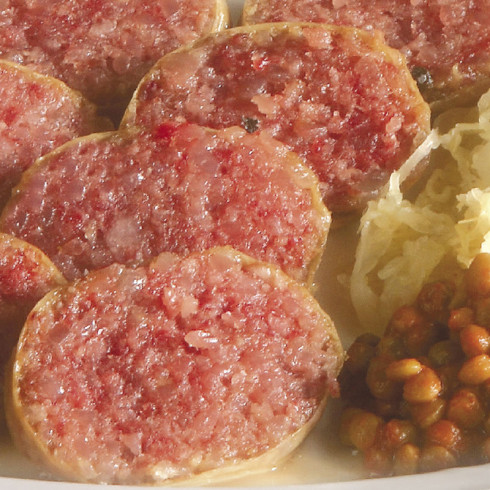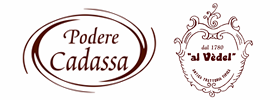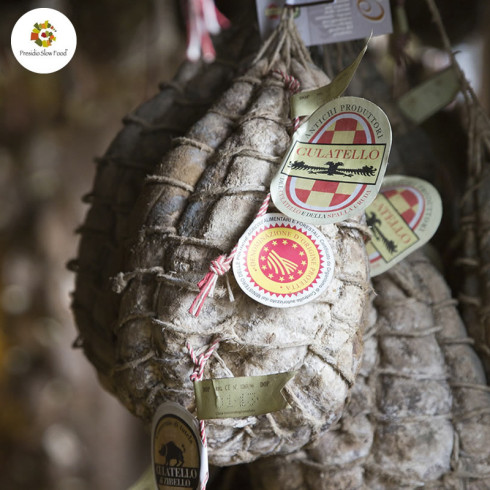
CULATELLO DI ZIBELLO DOP
Produced with the heart of the ham, the noblest cut of meat a pig offers, Culatello di Zibello DOP is one of the most prestigious products of the Italian Charcuterie tradition. Once extracted form the deboned and defatted central part of the pig’s leg, the selected cuts cured with salt for about 5 days. At the end of this process, they are washed with wine, stuffed into pig bladders and carefully tied by hand, giving it its typical pear shape. Culatello di Zibello DOP is produced solely from September to February, when the air is still, fog is thick and temperatures hover around 0°C. The aging process is carried out in natural Cellars, characterized by specific levels of humidity and windows that guarantee the correct air exchange, necessary elements in obtaining an optimal end result.
Boasting its seal, Culatello di Zibello by “Podere Cadassa” is approved by the DOP Consortium, as well as the Antichi Produttori Association. Furthermore, it is a Slow Food Presidium. These certifications guarantee qualitative superior products that have been rigorously selected.
spalla cruda di palasone
Known to gourmets as Spalla Cruda di Palasone, because “Palasone di Sissa” is the name of the small town along the Po river where this sausage was born, Spalla Cruda is a typical charcuterie of the Po Food Valley. Made only during winter months, it’s produced with meat coming from the pig’s shoulder and neck; it can be with or without bone. The meats are first cured with salt and pepper, then stuffed into the pig’s bladder and aged in Natural Cellar from 12 to 20 months. Slightly pear shaped and weighting from 2 till 6 Kg, the original hand-made Spalla Cruda is characterized by a compact texture, an intense perfume and meats that red in color presenting fine veins of fat.
Spalla Cruda by Podere Cadassa is a Slow Food Presidium and approved by the Antichi Produttori Association.
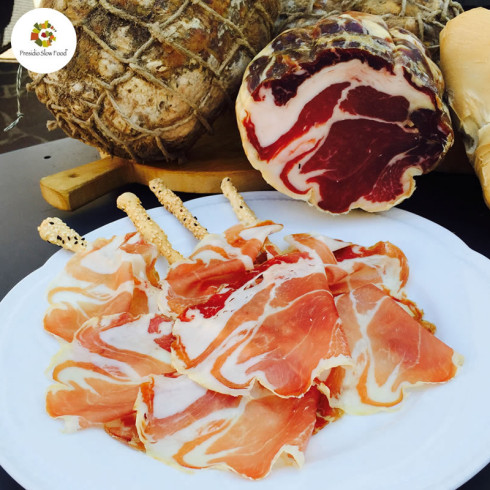
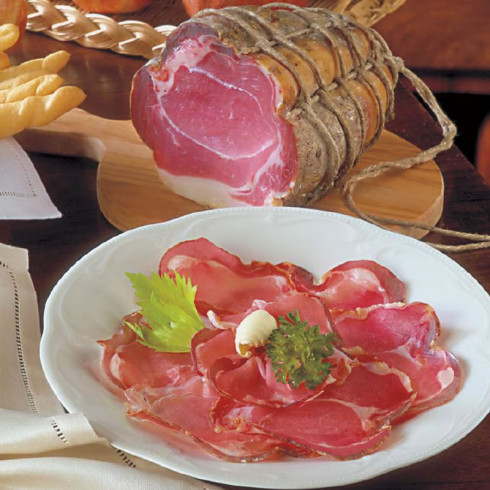
FIOCCHETTO
Fiocchetto or Fiocco is one of the most iconic Products of the Parma’s Charcuterie. Produced exclusively from carefully selected local drifts, Fiocchetto is made with low-fat cuts coming form the front of the pig’s leg and is aged in natural cellars. Because of its low fat content, aging can be as short as 8-10 months. Fiocchetto is traditionally seasoned with salt and small quantities of peppercorn to then be stuffed into pig bladder and hand tied.
coppa
Coppa is a Charcuterie coming from the highest part of the pig’s neck. Podere Cadassa’s Coppa boasts all the traditional features of Coppa produced around Parma, where this single-cut cured meat is longer than in other parts of Italy. Because of this peculiarity, production of this delicacy goes by the name of “7 coste”, meaning 7 ribs, indicating the number of ribs involved in obtaining the necessary meats.
As per the whole Podere Cadassa range, Coppa is a natural Product belonging to Parma’s tradition of artisanal pork butchery.
Seasoned when still hot solely with sea salt and a little pepper, the meats are then stuffed into pig bladders, bound by hand and dried. To complete the process, Coppa refines by aging in Natural Cellars for at least 8 months.
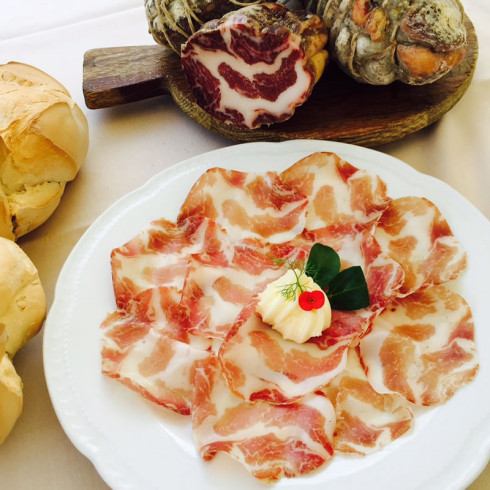
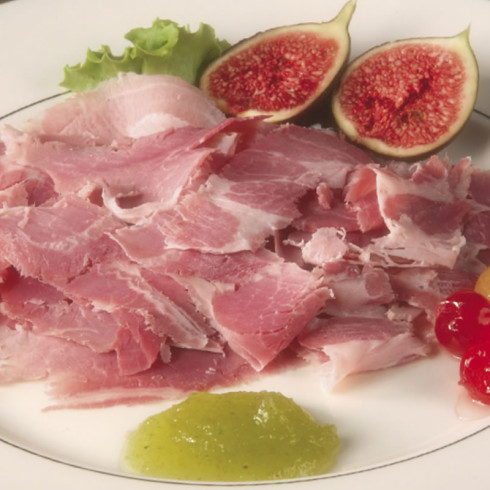
SPALLA COTTA DI SAN SECONDO
Spalla Cotta di San Secondo is one of the most typical and ancient charcuteries of the Po. It consists of the front part of the shoulder of the heavy local pigs, deboned and free from the external rind. As soon as the animals are slaughtered, the meat is processed with dry sea salt, some ground pepper and small quantities of nitrites, aimed at preserving the typical pink color that characterizes this product. After 12 days of salting, the meat is bound by hand, left to drain, aged for about 1 month and then boiled at 70°C for 8/10 hours in a court-bouillon enriched with dry Marsala wine and laurel leaves, as per tradition. Spalla is fully enjoyed when served warm and cut by hand. “Gnocco fritto”, a type of fried bread, or some home-made bread leavened naturally are the ideal accompaniments for this succulent meat. The production of Spalla Cotta is very ancient, with documents dating back to 1170 reporting it being prepared for the Parma Dioceses as a mean to pay taxes. Maestro Giuseppe Verdi is to be thanked for the fame Spalla Cotta enjoys, often mentioning it as one of his favorite foods. His love for this preparation was so great that it was usual for him to gift it to his guests.
MARIOLA
Mariola is one of the most prized charcuteries of the Po Valley, characterized by an extensive ageing phase. Made with high quality trimmings obtained by the production of Culatello, Coppa and Spalla, minced and then seasoned with salt and a little pepper, the metas are stuffed only in bladders of the highest quality, called mariola, form which this unique salami takes its name. It is thanks to these selected ingredients and its large diameter that Mariola can enjoy ageing periods of up to 4 months, conferring it spectacular taste and appearance. In spite of such a long maturation, Mariola’s meat remains soft while the casing boats wonderful natural molds, conferring this Product the flavors and aromas typical of the natural cellar.
Historically, Mariola could be consumed either cooked or raw. Here at Podere Cadassa we prefer the raw one, considered to be the most precious, originally consumed exclusively by the noblest families.
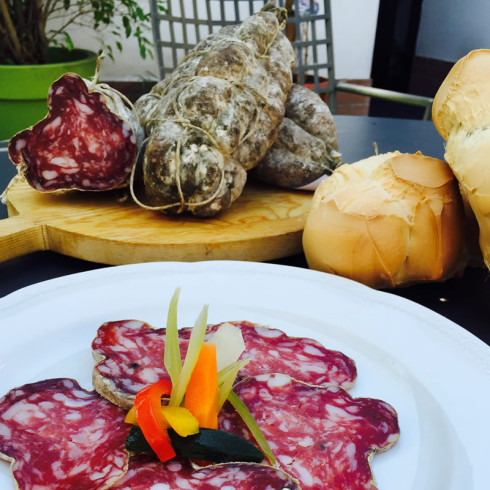
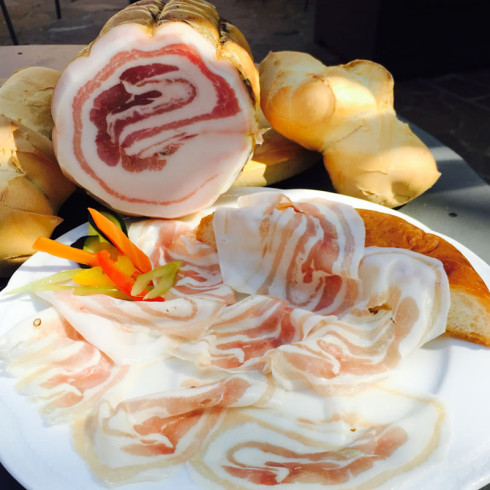
pancetta
Pancetta by Podere Cadassa is produced following the guidelines set by Parma’s traditional butchery practices utilizing pig bellies that present the right balance of fat and meat. Pancetta is obtained by tightly rolling these wide and flat cuts of onto themselves, almost forming a spiral, and are protected on the outside by a portion of the animal’s skin. Free form preservatives of any kind, the finished products spend at least 12 months ageing in Natural Cellars, where they develop traits unique to this preparation: rosy pink fat, delicate flavors and thin slices that melt in the mount.
SALAME GENTILE
Salame Gentile is a cured sausage unique to Parma’s culinary tradition. Its peculiar sweet taste and soft texture, making it stand out from all other salamis, are the result of a specific production method. To begin with, the meats are coarsely ground and seasoned following an old family recipe that calls only for salt, pepper and a little honey, rendering the use of any type of preserving agent superfluous. The mix is then stuffed in very thick natural casings, aimed at preserving moisture, dried for a few days and finally brought into the Natural Cellar, where it ages for at least 4 months. In this fantastic environment, humid and ventilated, the salamis maintains their compact texture and vividly colored meat while further developing their characteristic sweetness.
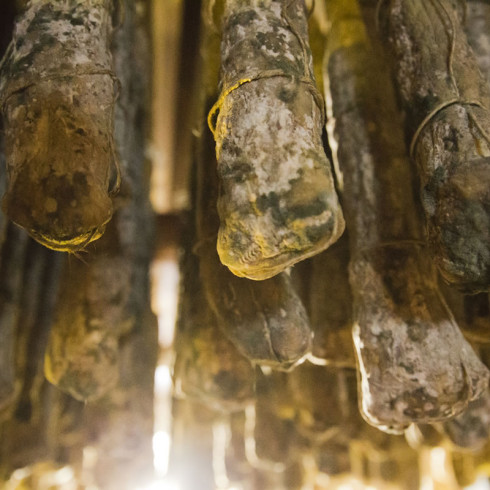
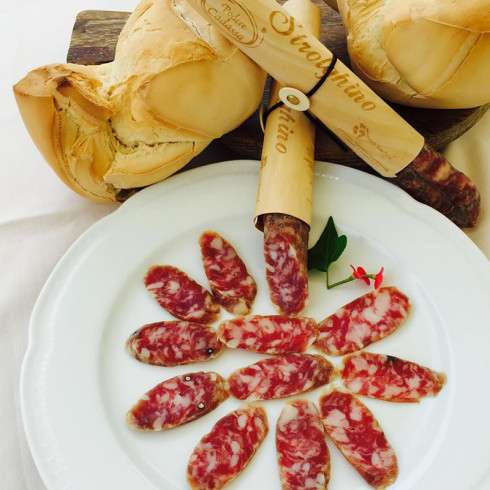
strolghino
Amongst the different salami varieties, Strolghino is the one that best defines the Food Valley: its smaller than average size and fresh meats are traits than intimately bind it with the culinary tradition of our region. Prepared following an old family recipe, trimmings obtained during the production of Culatello are lightly seasoned with salt, peper and small doses of honey. The mix is then stuffed into thin and long casings made up of pig intestines and aged for about 20 to 30 days. After this period, as soon as the noble molds start forming on thesurface, Strolghino is ready to be consumed.
Traditonally stolghino was consumed in those wointer months that followed slaughter, providing families with enough
In the past Strolghino used to be consumed in winter, in the period immediately following the slaughter, a ritual that provided rural families with meat for the year. Regardless of its past as a “family food”, Strolghino’s freshness and palatability make it the perfect salami, versatile enoguht ot be served as an aperitif, finger food or a as a starter.
cotechino
Cotechino is a unique sausage prepared with pig rinds and meat coming form the rear shanks. These cuts are coarsely ground, seasoned with salt, flavored with a mix of spices and, after being stuffed in a natural casing called “crespone”, dried for 10 days. Before reaching the table, Cotechino’s casing must be punctured in multiple places, tightly wrapped in a cloth or some foil, and cooked in gently simmering water for around 3 to 4 hours.
A prominent dish in Emilia’s rural culture, Cotechino is consumed mainly in winter, where it’s a traditionally served alongside pulses, principally lentils, mash potatoes or as an ingredient in soups. With records dating back to 1745, this wonderful product boasts a very long and fascinating history, figuring also in Pellegrino Artuis’s famous work “La scienza in cucina e l’arte di mangiare bene”.
